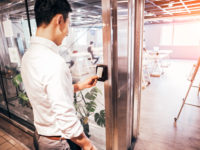IF YOU WERE TO ASK A SECURITY PROFESSIONAL what words come to mind with the phrase access control, terms like door solutions, readers and credentials would be a few of the likely responses. There’s one phrase, however, that they probably won’t say: sustainability.
“It’s not necessarily first nature for most people to think about doors and hardware and access control products being sustainable,” says Amy Musanti, director of sustainability at ASSA ABLOY.
Yet some door hardware and lock manufacturers say sustainability and access control go hand-in-hand, starting from the materials in the products themselves to creating more efficient, environmentally friendly buildings.
It’s Easy Being Green
Incorporating green access control products is not as expensive or complicated as one might think.
“These products that we have developed and marketed as sustainable are not given a price increase or an upcharge because of their sustainability attributes,” Musanti says. “Our intention is to get away from this idea that an efficient and progressive building has to be more expensive.”
According to Steve Carney, vice president of product marketing for physical access control solutions at HID Global, Austin, these green capabilities are built into its new products, meaning there is no added cost to purchasing a green product.
“It’s more of a cost benefit than it is an ROI analysis,” Carney says.
For example, HID’s Signo readers all include Intelligent Power Management (IPM), which reduces reader current consumption by up to 40 percent. Additionally, HID Global has partnered with GreenCircle, an environmental certification company, to provide third-party validation on its sustainable products.
Utilizing existing infrastructure in a building, like Power over Ethernet (PoE) or Wi-Fi, is another easy way to go green.
Kerby Lecka, director of marketing at Security Door Controls, Camarillo, Calif., says solutions that use solenoids tend to use more energy than PoE or Wi-Fi solutions. And, with almost every building having Ethernet or Wi-Fi, it’s a practical switch to make.
“It’s pretty rare you’d find a building that didn’t have [Ethernet] because of the ubiquity of us being on the internet and Wi-Fi,” Lecka says.
According to Musanti, utilizing PoE or Wi-Fi solutions prevents “reinventing the wheel” when upgrading systems, allowing for cost-effective and earth-friendly ease.
“Using existing infrastructure is a much lower energy solution — around 85 percent [less] than a typical access control solution,” Musanti says.
Sustainability: Not Just in the Products
For many of these companies, sustainability practices come from the top down.
Steve Carney at HID Global notes that many European-based companies — including HID’s parent company, ASSA ABLOY, headquartered in Sweden — tend to focus on sustainability more than American-based companies, using his own personal experience as an example.
“When we think about sustainability, Europeans have always really led the way,” Carney says. “In the early 90s, I was in the military in Germany, and even back then, when you went to a store and bought a packaged item, that store was obligated to take the packaging back. That made manufacturers in Europe much less likely to wrap something in a box within another box. I really think this is cultural in nature for us.”
According to Amy Musanti, ASSA ABLOY, the company looks at the environmental footprint of its manufacturing sites and utilizes the sustainability compass to create products with the smallest environmental footprint possible.
“When you have such a global footprint, you also have a large global responsibility,” Musanti says.
Johnson Controls, with global headquarters in Ireland, has a similar top-down mentality when it comes to sustainability. In February of this year, the company announced that it joined the Climate Pledge, an environmental commitment co-founded by Amazon and Global Optimism, to reach net-zero carbon emissions by 2040 — 10 years ahead of the goal set out in the United Nation’s Paris Climate agreement.
“Seventy-five percent of all of our research and development will be aimed at addressing sustainability,” says Katie McGinty at Johnson Controls.
That doesn’t mean American companies can’t adopt sustainable practices. California-based Security Door Controls follows sustainable code requirements for manufacturing required by the state.
“We have to meet those criteria to operate,” Kerby Lecka says.
Efficient & Effective
Reducing energy costs for the environment ends up being more cost effective for a building. Less electricity outputted equals lower energy bills, according to Musanti.
“The lower energy usage equates to dollars saved, which makes sustainability a relevant story for any stakeholder involved,” Musanti says.
According to Katie McGinty, vice president and chief sustainability, government and regulatory affairs officer at Johnson Controls, Milwaukee, COVID-19 has sped up sustainability efforts. Despite an 80 percent reduction of occupancy in buildings, COVID-19 has only yielded a 20 percent reduction in energy.
“The multiple crises we’ve all been working through as a community have enabled us to see more clearly how these pieces come together and … [dial] down the energy and other utilities that might be running in the corner,” McGinty says.
Advances in the industry have also had sustainable implications. Take touchless access control solutions, for example: mobile credentials and biometrics mean fewer plastic cards in use.
“Just the simple credentialing and the minimization of physical elements reduce its impact on both energy and the environment in its manufacturing and its ongoing use,” says Rick Ruppert, manager, architectural services, dormakaba, Indianapolis, pointing to dormakaba’s Saffire line as an example.
According to Carney, looking at who is using what rooms, how often they are using that room, and when they are using that room can help with reducing energy and costs. By leveraging installations and adding layers of technology to it — such as machine learning or artificial intelligence — building managers can manage their electricity and heating using historical data.
“At the end of the day, if you’re more efficient, you save money,” Carney says.
Musanti says buildings can have a high level of access control while helping the planet and being budget-friendly.
“Our goal is to help customers understand that you can still have the security and the functionality and even the aesthetics of a product and incorporate sustainability without having to pay any more or without having to make any type of change to the product itself,” Musanti says.






![Screenshot_Security-Score_SC5.8-Dashboard_2736x1824_3x2[1] Screenshot_Security-Score_SC5.8-Dashboard_2736x1824_3x2[1]](https://www.sdmmag.com/ext/resources/Issues/2020/April/Screenshot_Security-Score_SC58-Dashboard_2736x1824_3x21.jpg?height=200&t=1586793661&width=200)

